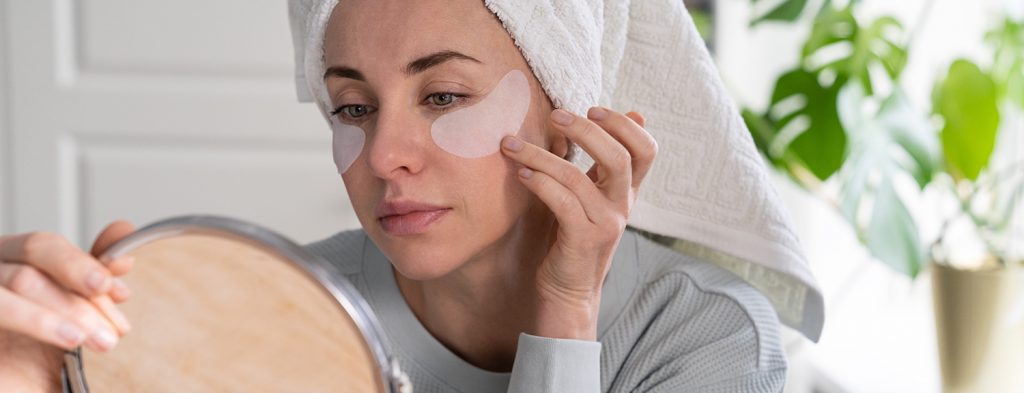Under-eye wrinkles are an inevitable part of the aging process. You may notice these crinkles before other lines on your face because the skin around the eyes is thinner and more fragile than in other areas. Furthermore, it also doesn’t have any sebaceous (oil) glands to keep it lubricated. Along with intrinsic (chronological) aging and a loss of collagen and elastin, causes of wrinkles under the eyes include:

- Sun exposure
- Smoking
- Alcohol
- A high sugar diet
- Sleeping position
- Rubbing your eyes
- Allergies
- Facial expressions
- Genetics
- Dehydrated skin
While eye wrinkles cannot be erased, you can minimize their appearance. Here are 16 ways to help prevent and soften crinkles around the eyes.
1) Buy a Good Under-Eye Wrinkle Serum And Cream
The simplest and most cost-effective way to visibly tackle eye wrinkles is to invest in a good eye serum and cream and use it daily.
Start with a serum designed for under eye wrinkles and visible signs of aging and damage. Serums have a higher concentration of actives and penetrate deeper into the skin. They are the workhorses of a skincare routine and work like derm treatments. Our top pick is Carrot & Stick The Eye Serum.
Follow with an eye cream. We recommend Carrot & Stick’s Eye Cream. This product helps visible lift and smooth the skin around the eye while supporting natural collagen and elastin.
Carrot & Stick’s Eye Essentials contains both products and is an optimal treatment program for lines around the eyes.
2) Apply SPF
Choose a hydrating eye cream that is spiked with a good SP, so the cream does double duty by moisturizing the eye area while protecting it from the sun’s harmful UV rays. Heavy-duty sun blockers include zinc oxide, which forms a physical barrier against the sun, and titanium dioxide. Choose a water-resistant formula if you plan to be at the beach or the pool, or a tinted formula for the day. You may need to experiment with several different brands to see which ones feel good on the eye area and don’t leave you looking chalky.
3) Apply An Eye Patch
Let’s say you have a big night out or woke up looking incredibly weary. One of the simplest ways to achieve a quick fix is to apply an eye patch to perk up the area. These crescent-shaped pads are soaked with hydrating ingredients such as shea butter, jojoba oil, and hyaluronic acid. This under-eye wrinkle treatment temporarily fills in fine lines and plumps up the skin while preventing makeup from settling into creases.
4) Consider Microneedling
Simply put, microneedling is a skin-rejuvenating procedure where tiny needles puncture the skin to trigger the healing process. Think of it as a controlled injury. The concept is that during the healing process, the body creates collagen and elastin, leading to smoother, firmer skin, and fine lines appear less noticeable. A numbing cream is applied before the procedure, but it’s not for the faint of heart. A dermatologist or aesthetician can perform Microneedling. However, you can also perform it at home by purchasing your own derma rollers — although you won’t be able to go as deep like a pro.

5) Drink Enough Water
Water is critical for the skin’s health and function, and properly hydrated skin looks smooth and supple. Sometimes tiny lines around the eyes can be caused by dehydration rather than aging, so remember to reach for your eight glasses of water a day. Buy a refillable bottle and keep it at your desk as a reminder to drink up — add a few slices of lemon or cucumber if you find plain water boring.
6) Stop Smoking
Cigarettes contain more than 4,000 chemicals that damage collagen and elastin. The nicotine in cigarettes causes the blood vessels to constrict in the skin’s outer layers, which impairs blood flow. Decreased blood flow means your skin isn’t getting as much oxygen or vital nutrients like vitamin A. Here’s some additional food for thought: The unhealthy, worn skin of a 40-year-old heavy smoker resembles that of a non-smoking 70-year-old.
7) Get Ample Shut-Eye
Getting a good night’s sleep is essential for everyone, but it’s not always easy to accomplish — but it’s vital to make an effort. Nighttime is when our bodies heal, and without a solid seven or eight hours of sleep, it won’t have proper time to repair itself. Sleep deficiency can cause a whole host of problems, from an increased risk of health issues to sallow, sagging skin. Studies suggest that a lack of sleep exacerbates fine lines and wrinkles.
8) Sleep On Your Back
While getting enough sleep is critical, how you sleep also plays a role in preventing wrinkles. If you sleep on your side with your face pressed against the pillow, it can lead to the creation of deep under-eye creases. Repeated pressure or repetitive muscle motion in one targeted area breaks down collagen, resulting in visible lines. Try to sleep on your back or switch to a smooth satin or silk pillow to reduce creasing. Consider buying a specialty pillow that’s designed to keep you on your back.
9) Ease Up on the Alcohol
Alcohol, like cigarettes and the sun, can also speed up the aging process. Studies show that alcohol also causes peripheral vasodilation, which means the facial capillaries become dilated. This leads to wrinkles, and uneven skin tone, volume loss around the eyes.
10) Don’t Touch
Constant rubbing of the eyes can exacerbate fine lines by tugging and pulling on this delicate skin area. The more you rub, the more the skin stretches and breaks down collagen and elastin, causing deep under-eye creases. It’s a tough habit to break, but try to avoid rubbing your eyes if you’re tired. If you’re rubbing because your eyes are itchy, consider seeing a doctor to rule out allergies. Try not to touch the eye area unnecessarily — for example, avoid tugging on the eyes when applying or removing makeup.
11) Eat a Healthy Diet
Beautiful skin often starts from within, so make sure you eat a healthy diet full of a wide variety of fruits and vegetables and avoid processed and sugary foods. Think of it as feeding your face and eating your way towards wrinkle reduction. Foods rich in vitamins C, E, and A and coenzyme Q10, found in fish, are antioxidants that can help reduce and prevent aging signs. Salmon and mackerel are packed with Omega-3’s, which help moisturize the skin and protect it from UV damage. Carrots have high levels of beta-carotene — a nutrient that is known to help protect the skin against free radical damage.
12) Make Your Own Mask
Women all over the world have been treating their skin with homemade remedies for centuries. There are a few natural, homemade remedies that are gentle but effective on the eye area. One under-eye wrinkles home remedy is egg whites. They contain collagen and protein, which help to firm skin and tighten the area. To make a simple mask, whisk the egg whites until frothy and apply to the eye area using an upward motion. Allow the mixture to dry for 15 minutes before rinsing with warm water. Avocados can also be effective, and some people swear by coconut oil.
13) Reach for a Retinol
When it comes to tackling fine lines and wrinkles with a product, there’s no comparison to retinol. The vitamin A derivative stimulates collagen production that prevents fine lines. Retinol should be applied at night because it makes the skin more sensitive to the sun. It’s best to slowly introduce retinol into your routine (and with a hydrating moisturizer), lest you run the risk of making under-eye circles worse.
14) Massage With Oil
Massaging the skin not only feels relaxing, but it helps to stimulate blood flow to the area. Use extra precaution massaging the delicate eye area, as you don’t want to pull and tug the thin skin here. Dip your pinkie into an oil (coconut or olive work well) and gently rub from the inside corner of the eye to the outside; repeat. There are also several at-home devices that are designed specifically for face massage too.
15) Chemical Peels
Chemical peels can be quite effective for getting rid of under-eye wrinkles by resurfacing your skin. In other words, peels give your skin a deep and thorough exfoliation to expose the fresh, new skin beneath. After the treated areas heal, your new skin is healthier and thicker and less likely to under-eye wrinkles. To maintain the results, you’ll have to get a peel each month.
16) Laser Resurfacing
As with chemical peels, laser resurfacing is typically used to treat minor under-eye wrinkles on the skin’s top layer. The laser beam breaks down the epidermis (the top layer of skin) and stimulates new collagen to grow underneath. While results can be favorable, you’ll need to repeat laser treatments every few months. Keep in mind that there’s also a risk of hyperpigmentation and scarring.
The Final Word
Under-eye wrinkles are an inevitable part of the aging process, and you may notice these crinkles before other lines on your face because the skin around the eyes is thinner and more fragile than in other areas. Furthermore, it also doesn’t have any sebaceous (oil) glands to keep it lubricated. Along with intrinsic (chronological) aging and a loss of collagen and elastin, A few causes of wrinkles under the eyes include sun exposure, allergies, smoking, and sleeping position. While eye wrinkles cannot be erased, you can minimize their appearance.
Start with a good eye serum specifically designed for aging around eyes. We recommend Carrot & Stick The Eye Serum. Serums are more concentrated and penetrate deeper. Follow with Carrot & Stick The Eye Cream.
Carrot & Stick’s Eye Essentials contains both products and visibly targets lines around the eyes.
Sources:
Photoaging: What You Need to Know About the Other Type of Aging,” Skincancer.org, January 2019.
“Is it True That Smoking Causes Wrinkles,” Mayo Clinic.
“Smoking and its Effect on the Skin,” DermNet, November 2016.
“Impact of Smoking and Alcohol Use on Facial Aging in Women,” US National Library of Medicine National Institutes of Health, August 2019.







